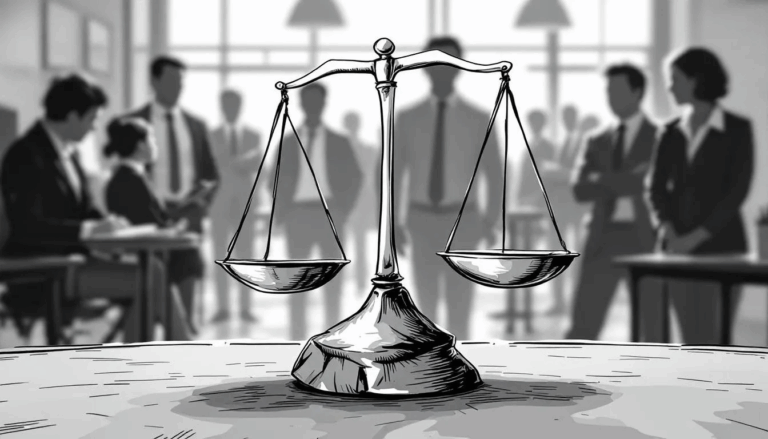Disparate impact happens when neutral policies unintentionally harm protected groups like minorities or women more than others. This type of discrimination doesn’t require intent to discriminate, but its effects are significant. This article will explain what disparate impact is, its history, and how it affects areas like employment, education, and housing. Here is a link to our article with more about disparate impact, as well as a post below:
Key Takeaways
- Disparate impact can occur without intent, affecting protected groups negatively through seemingly neutral policies, highlighting the need for fair workplace practices.
- The 1971 Supreme Court case Griggs v. Duke Power Co. set a legal foundation banning employment practices that disproportionately harm racial minorities, influencing ongoing civil rights laws.
- Recent Executive Order 14281 shifts the focus away from enforcing disparate impact liability in employment, prompting employers to reassess hiring practices and compliance with anti-discrimination laws.
Understanding Disparate Impact

Disparate impact refers to practices that, while seemingly neutral, adversely affect one group of protected characteristics (such as race, sex, or disability) more than another. This form of discrimination occurs without the need for intent; it’s about the effect rather than the motivation behind a policy. Unlike disparate treatment refers, which involves intentional discrimination, disparate impact is often associated with unintentional discrimination.
Consider a company that implements a policy requiring all job applicants to pass a credit check. Although this may appear neutral, it could disproportionately exclude applicants from certain racial or economic backgrounds, resulting in disparate impact discrimination. Such policies, although not designed to discriminate, can create significant barriers for protected groups and may have an adverse impact on these individuals. Another example is when a company requires a college education for all positions, which can act as a barrier to employment for individuals from marginalized communities who may have less access to higher education. This type of requirement can lead to disparate impact claims if it disproportionately affects individuals based on a protected characteristic.
Addressing disparate impact is key to achieving substantive equality. Examining and adjusting policies that inadvertently harm certain groups can foster a more inclusive and equitable workplace, upholding the principles of equal employment opportunity and ensuring fair treatment for all.
Historical Context and Legal Foundation
The concept of disparate impact was solidified in the landmark Supreme Court case Griggs v. Duke Power Co. in 1971. The court ruled that employment practices must not disproportionately affect certain racial groups unless they are directly related to job performance. Disparate impact theories allow for legal liability without proof of intent, and are used in both employment and housing discrimination cases. This ruling emphasized that even without discriminatory intent, employers could not enforce job requirements that inadvertently excluded minorities.
The Griggs decision underscored the need to eliminate unnecessary barriers to employment that discriminate against unlawful discrimination. It paved the way for disparate impact claims under Title VII of the Civil Rights Act of 1964, which prohibits discrimination based on race, color, religion, sex, or national origin. While disparate impact claims address neutral policies with adverse effects, a disparate treatment claim involves intentional discrimination against an individual based on a protected characteristic. Title VII protects individuals based on membership in a protected class, such as race, gender, or disability. This legal foundation has been crucial in promoting equal access to employment opportunities for all protected characteristics and civil rights laws.
The supreme court held that testing and other employment criteria must be demonstrably related to the job, setting a precedent that continues to influence employment law today. This historical context is crucial for understanding the evolution and current application of a demonstrable relationship with disparate impact theory.
Evolution of Disparate Impact Theory

Over the years, disparate impact theory has evolved and expanded beyond its original context. States that have established disparate impact liability under their anti-discrimination laws include:
- New York
- California
- Illinois
- Colorado
- Minnesota
This demonstrates the broadening acceptance and application of disparate impact provisions across various respective jurisdictions, including disparate impact cases.
The recent executive order may challenge this expansion, setting the stage for arguments that state laws’ endorsements of disparate impact liability are inconsistent with federal civil rights laws and public policy. Such laws highlight the ongoing tension between state and federal authorities in regulating employment practices and protecting civil rights, including the need to warrant federal action and comply with federal law. The federal government plays a central role in shaping anti-discrimination enforcement, as executive actions and federal agencies can impose disparate impact liability or seek to limit it. Notably, the executive order seeks to eliminate disparate impact liability to the maximum degree permitted by law, reflecting a significant policy shift.
Despite these challenges, disparate impact theory remains essential for identifying and addressing discriminatory practices. Examining how facially neutral employment practice policies disproportionately affect particular groups promotes equal access and helps eliminate systemic barriers to employment and other opportunities.
Application Beyond Employment
Disparate impact analysis is not limited to employment decisions; it extends to various sectors, highlighting the pervasive nature of unintentional discrimination. In education, for instance, policies that unfavorably impact specific student demographics, such as race or disability, are scrutinized to ensure fairness. It is essential to use appropriate methods to evaluate whether these policies promote equal opportunity and comply with anti-discrimination laws. In housing, the Fair Housing Act mandates that any practice resulting in disparate impact on protected groups must serve a legitimate, non-discriminatory purpose.
Healthcare is another area where statistical disparity is significant. Policies that disproportionately affect certain patient groups based on characteristics like age or disability are examined to ensure equitable access to medical services. In the criminal justice system, practices that unfairly target specific racial or ethnic groups are identified and addressed. This practice disproportionately affects a particular group of specific communities.
Voting rights legislation is also scrutinized under disparate impact theory to assess how laws may differentially affect various demographic groups. This broader application underscores the theory’s importance in promoting fairness and equality across multiple domains.
Recent Changes: Executive Order 14281

President Donald Trump issued Executive Order 14281, titled ‘Restoring Equality of Opportunity and Meritocracy’, marking a significant shift in the enforcement of disparate impact liability. The order:
- Aims to eliminate the use of disparate-impact liability in all contexts, signaling a major change in federal policy.
- Instructs federal agencies to reduce enforcement of regulations imposing disparate-impact liability.
- Directs agencies to assess existing regulations related to disparate-impact liability.
This executive order reduces the deprioritize enforcement of disparate impact claims, reshaping the litigation landscape for employers. However, employers must stay informed about evolving interpretations and issue guidance, as changes in enforcement may affect compliance with anti-discrimination laws. Even if federal agencies deprioritize enforcement, private parties can still bring disparate impact claims under federal law, such as Title VII.
Despite the reduction in federal enforcement, the ongoing risks for employers remain. The Equal Employment Opportunity Commission (EEOC) and the Department of Justice (DOJ) continue to review cases related to disparate impact liability, indicating that vigilance and compliance are still necessary. If you want more background, here is a link to an article about major employment law court cases.
What This Means for Employers
For employers, the recent changes mean a renewed focus on ensuring that hiring practices comply with both federal and state anti-discrimination laws. Employers must evaluate their hiring process and employment practice in light of the current administration’s priorities and determine whether any employment decision changes are necessary.
The Equal Employment Opportunity Commission (EEOC) and the Department of Justice (DOJ) are actively reviewing cases related to disparate impact liability, which indicates ongoing risks for employers. This underscores the importance of staying informed about legal developments and understanding how they may impact business operations.
Employers should:
- Actively identify and mitigate potential risks associated with disparate impact claims.
- Regularly review and adjust policies to ensure compliance and take appropriate action.
- Regularly analyze the company’s hiring rate for disparities among different groups, using statistical methods such as the 80% rule to identify and address potential discrimination.
- Promote equal employment opportunities.
How employers defend against Disparate Impact Claims

Defending against a disparate impact claim requires a strategic approach. Employers must:
- Prove that their policies are closely related to job duties.
- Demonstrate that the policies are consistent with business necessity.
- Show that the challenged practice is job-related for the position.
- Ensure the practice aligns with legitimate business needs.
A critical aspect of the defense involves:
- Disproving the existence of a less discriminatory alternative to the challenged policy.
- Showing that there is a legitimate, nondiscriminatory reason for their employment policy or practice.
- Ensuring that the reason is consistent with business necessity.
Thoroughly documenting the rationale behind policies and practices allows employers to build a strong defense against disparate impact claims. This proactive strategy helps mitigate risks and ensures compliance with anti-discrimination laws.
Best Practices for Employers

Employers can reduce the risk of disparate impact liability by adopting best practices that promote equal employment opportunities, including:
- Conducting regular evaluations of hiring practices to ensure compliance with equal employment opportunity standards.
- Verifying that all policies, practices, job requirements, and tests, including pre employment testing, are necessary for the position.
- Ensuring that these policies and practices do not adversely affect certain groups when appropriate measures are available.
Removing unnecessary educational requirements can help eliminate barriers to equal employment opportunities for female applicants. Creating policies that allow for diverse hiring practices can also help mitigate risks associated with disparate impact liability. Employers are encouraged to seek technical assistance to better understand methods to promote equal access to employment.
Implementing these best practices and alternative practices helps employers foster a more inclusive and equitable workplace, reducing the likelihood of disparate impact claims and promoting a positive organizational culture for protected classes.
Summary
The future of disparate impact is shaped by evolving legal interpretations and regulatory changes. Understanding the concept, historical context, and recent developments is crucial for employers to navigate this complex landscape. By staying informed and proactive, employers can ensure compliance with anti-discrimination laws and promote equal employment opportunities.
In conclusion, while the recent executive order marks a significant shift in federal policy, the importance of addressing disparate impact remains. Employers must continue to evaluate and adjust their practices to foster a fair and inclusive workplace. Staying vigilant and informed is key to navigating these changes and ensuring compliance with both federal and state laws. If you think you may have a claim, here is a link to a free online tool to help evaluate your claim.
Frequently Asked Questions
What is the title of the executive order issued by President Donald Trump regarding disparate impact claims?
The title of the executive order by President Trump is “Restoring Equality of Opportunity and Meritocracy.”
What does the theory of disparate impact allow an employee plaintiff to demonstrate?
The theory of disparate impact lets an employee show that a seemingly neutral job practice actually has a negative effect on a specific protected group. So, if a policy hurts a particular class more than others, you can make a case against it.
What must employers prove when defending a disparate impact case?
Employers need to show that their practice is actually relevant to the job and serves a necessary function for the business. That’s the key to defending a disparate impact case.
What does the executive order state about the use of disparate-impact liability?
The executive order aims to eliminate disparate-impact liability as much as possible across all contexts. Basically, it’s pushing for a pretty significant change in how those cases are handled.
What action must the EEOC Chair and Attorney General take within 45 days according to the executive order?
The EEOC Chair and Attorney General need to check out all pending investigations and civil suits that involve disparate impact theory within 45 days. It’s all about reviewing what’s on their plates!



